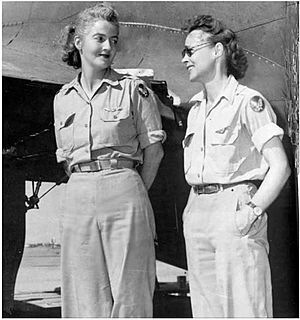Betty Gillies facts for kids
Quick facts for kids
Betty Huyler Gillies
|
|
|---|---|
 |
|
| Born | January 7, 1908 Syosset, Long Island, New York
|
| Died | October 14, 1998 (aged 90) San Diego, California
|
| Occupation | Aviator Spokesperson |
| Spouse(s) | Brewster Allison "Bud" Gillies |
Betty Gillies (born January 7, 1908 – died October 14, 1998) was an amazing American aviator. She made history as the very first pilot to join the Women's Auxiliary Ferrying Squadron (WAFS). This group later became part of the famous Women Airforce Service Pilots (WASP) during World War II.
Contents
Early Life and Learning to Fly
Betty Huyler was born in 1908 into a well-off family on Long Island, New York. She started learning to fly in 1928 while she was training to be a nurse in New York City. On May 6, 1929, after only 23 hours of flying lessons, she earned her pilot's license.
Betty quickly started flying more to get a commercial pilot's license. In November 1929, she joined The Ninety-Nines. This is an international group for women pilots. The famous pilot Amelia Earhart was the first leader of this group. The name "Ninety-Nines" was chosen because 99 women attended the first meeting, and Betty was one of them!
Between 1939 and 1941, Betty was the president of The Ninety-Nines. She worked hard to change rules that stopped women from flying. Later, she owned and flew a special type of plane called a Grumman Widgeon amphibian, which could land on both land and water.
In 1930, Betty Huyler married Brewster Allison "Bud" Gillies. He was a vice president at the Grumman Aircraft Corporation, a company that built airplanes.
Flying for Her Country in World War II

In 1942, Betty Gillies became the very first pilot to qualify for the Women's Auxiliary Ferrying Squadron (WAFS). She joined the WAFS on September 12, 1942. By this time, she had already been flying for 14 years! She had flown a total of 1,400 hours and held many different flying certifications.
When another important pilot, Nancy Love, moved to Dallas, Texas, to start a new WAFS unit, Betty Gillies took over. She became the leader of the WAFS pilots at the 2nd Ferrying Group in New Castle Army Air Base, Wilmington, Delaware.
First Woman to Fly the P-47 Thunderbolt
In early March 1943, Betty Gillies made history again. She became the first woman to fly the powerful Republic P-47 Thunderbolt fighter plane. To get ready, she learned all about the plane's systems, how it flew, and what to do in emergencies.
Long-Distance Ferry Missions
One of the most impressive missions for the WAFS squadron in Wilmington happened in April 1943. Betty led a flight of four Fairchild PT-26 planes. They delivered these planes from Hagerstown, Maryland, all the way to DeWinton, Alberta, Canada. That's a distance of more than 2,500 miles! The other three pilots on this long trip were Nancy Batson, Helen McGilvery, and Kathryn Bernheim. These planes were not very fast, cruising at only about 100 miles per hour.
The group started their journey on April 18. They stopped for the night in Joliet, Illinois, then in North Platte, Nebraska. After a very long flight, they reached Great Falls, Montana. On April 21, they flew the last part to DeWinton, Alberta. All four pilots were back at their base by April 23. Their commander praised them for delivering the planes quickly and efficiently. They also handled all the necessary paperwork, like flight logs and fuel reports.
Flying the B-17 Bomber
On August 15, 1943, Betty Gillies and Nancy Love became qualified to fly the huge Boeing B-17 Flying Fortress bombers as lead pilots. They delivered three of these large planes together that month. On September 2, 1943, Betty and Nancy started a mission to deliver a B-17F bomber to England. However, the mission was canceled before the plane left Goose Bay, Labrador.
Betty remained the squadron leader for the Women Airforce Service Pilots at New Castle Army Air Base. She continued in this role until the WASPs were officially ended on December 20, 1944.
Betty and her husband, Bud Gillies, had three children. Sadly, one of their children passed away at age four. Their other son and daughter both grew up to become commercial pilots. Even four of their grandchildren became pilots, continuing the family's love for aviation!
Life After the War
After World War II, Betty Gillies became a ham radio operator. She used her radio to connect phone calls from her home in California to ships far away in the Pacific Ocean. She even had a huge antenna pointed at the Antarctic! This allowed her to talk with staff and Navy people stationed there for Operation Deep Freeze. She also took part in the Navy's MARS program.
Betty stayed very involved in aviation. From 1953 to 1961, she was the leader of the All Woman Transcontinental Air Race (AWTAR). This was a famous air race just for women pilots.
In 1964, President Lyndon B. Johnson chose Betty Gillies to be part of the first Federal Aviation Administration Women's Advisory Committee. She passed away in 1998.
Awards and Honors
Betty Gillies received several important awards for her contributions to aviation. In 1977, she was given a Paul Tissandier Diploma from the Federation Aeronautique Internationale. In 1982, she received the National Aeronautic Association Elder Statesman of Aviation Award. These awards recognized her long and important career in flying.

